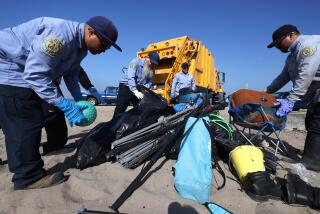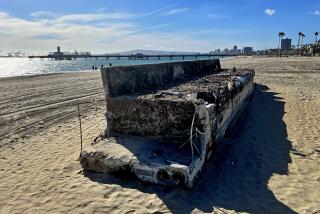‘Sand’ Packs Like Concrete : It’s Rough Going on Beach in Erie, Pa.
- Share via
ERIE, Pa. — Presque Isle State Park, with seven miles of beaches and a rich mix of lagoons, bays, ponds and marshes, is almost perfect, nearby residents say.
The 3,200-acre claw-shaped sand spit, deposited by ancient glaciers, shelters Erie harbor and lures beachgoers with Pennsylvania’s only surf swimming. Last year, more than 5.8 million park visitors contributed $150 million to the local economy.
If only Presque Isle had real sand.
Each year, the waves and currents of Lake Erie assault the Presque Isle beaches, washing away 281,000 cubic yards of sand. Each year, the U.S. Army Corps of Engineers dumps tons of replacement material on the beaches.
Local residents call the stuff dumped on the beach “dirty sand.”
‘Just Like Concrete’
“To call it sand is wrong. They ought to call it gravel. It packs down just like concrete,” said state Rep. Karl Boyes (R-Erie), minority vice chairman of the state House Conservation Committee.
“It’s not ‘dirty sand.’ It’s just dirt. All of us who lie on the beaches and swim would prefer as fine a sand as possible. Anything is better than what we’ve got on it,” said U.S. Rep. Thomas Ridge (R-Erie).
Bill Andolsek went a step further with his complaints. He spent $500 for 5,000 bumper stickers that read, “No More Dirty Sand at Presque Isle,” and handed them out for free.
Use for Potholes
“I live on a dirt road, and we’d use this stuff to fill potholes. You could land an airplane on this stuff,” said Jeff Nichols, 21, in his fourth year as a lifeguard at the park.
“It assaults your feet. It’s like something you’d use to make a driveway. It has an abrasive quality,” said insurance agent Don Wagner, 45.
“My mother used to come to the beach every day, but she won’t come anymore because it’s disgusting. You get all this prickly stuff on your feet. It used to be sand. Now it’s gravel,” said Tina Burroughs, 15, sunbathing on a recent 90-degree day.
The sand, which comes from a nearby gravel pit, is used because it is cheap and won’t wash away easily, Corps officials said.
Fake Sand a ‘Compromise’
“What we’ve put on is a compromise,” said Col. Denton Clark, chief of engineering for the Corps’ Buffalo, N.Y., District.
“I can’t deny it’s coarse, but it’s very difficult to get a better grade. The sand we’ve been putting on has been screened and washed, but one washing doesn’t get all the silt and clay out. If you washed it a second or third time, the cost would skyrocket,” Clark said.
Since 1955, the Corps has spent $19.4 million for nearly 11 million tons of sand. This year, it spent $1.45 million for 270,000 tons.
The Corps has been trying to stem erosion at Presque Isle for 162 years, not long after Commodore Oliver Hazard Perry built a fleet in Erie harbor that defeated the British in the War of 1812.
The peninsula’s neck has been breached four times since 1828, and the Corps has built a number of jetties, groins, sand traps and other erosion-control devices. Without the peninsula, an artificial barrier would be needed to protect the harbor.
Offer of Real Sand
Officials in Port Burwell, Ontario, a resort village located across Lake Erie in Canada, have volunteered one solution: Their harbor is choked with fine washed sand, and they’ve offered to give 5 million tons of it to Erie if the Corps pays the dredging and shipping costs.
“We just want to get rid of it. Our beaches are actually growing. It was probably your sand to start with,” said Elwood Varty, clerk-treasurer of Port Burwell.
Unfortunately, the offer is snarled in red tape. The Corps must adhere to a “buy American” code that says materials earmarked for public use and available at a reasonable cost must be domestic.
“You could use American ships. It would be American contracts. As far as we’re concerned, it’s American sand,” said Varty. “It isn’t exactly a national security item, is it?”
More to Read
Sign up for Essential California
The most important California stories and recommendations in your inbox every morning.
You may occasionally receive promotional content from the Los Angeles Times.













